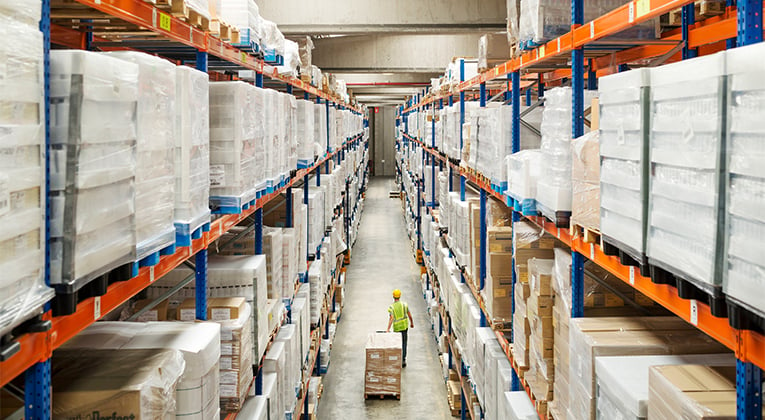We work with business leaders every week that are navigating the critical inflection point of scaling their logistics operations. Whether it’s an e-commerce brand looking to optimize fulfillment, a manufacturer expanding distribution or a retailer managing inventory across multiple markets, one of the biggest decisions they face is whether to lease/buy and operate their own warehouse, or outsource warehousing and fulfillment operations to a third-party logistics (“3PL”) provider. This strategic decision affects capital outlay, cash flow and cost control, flexibility, long-term business growth and risk. Here we break down the advantages and trade-offs of each option, giving you the insights needed to make an informed choice that aligns with your business objectives.
In-House Warehousing: Operational Control and Long-Term Investment
For businesses that require complete control over their inventory and logistics, due to security, quality or the volume of SKUs, managing an in-house warehouse, whether leased or owned, can offer strategic benefits.
- Greater Control Across the Operations
While the initial investment in fitting up a building may be substantial in terms of racking, equipment and systems, the long-term financial stability and cost savings may be worthwhile for businesses with consistent, high-volume fulfillment needs or those that have thousands of SKUs that a 3PL may not service well. Operating one’s own warehouse provides businesses with greater control over inventory, quality, security, returns, customers and logistics, positioning it as a strategic option for long-term success. With custom layouts and workflows specifically designed to meet a company’s individual requirements, businesses can ensure that each step of the process aligns with their operational goals.
Direct staffing oversight also enhances efficiency, security and accuracy, allowing for immediate adjustments and improvements. Additionally, proprietary inventory management systems can be tailored to match the unique demands of the company, versus a “one size fits all” approach that is common with 3PLs. This is particularly beneficial for businesses dealing with specialized products, such as fragile items, temperature-sensitive inventory or luxury goods, as they can implement rigorous standards that 3PLs may not be able to accommodate. In addition, for a company operating its own warehouse, there is only one customer to care about—yourself—versus potential conflicts that might arise with the other customers of a 3PL operator.
- Full Control Over Costs and Operations
Running your own warehouse eliminates pricing volatility due to an increase in a 3PL’s labor cost or rent costs the 3PL might encounter and need to pass through. Also, you need to understand that 3PLs are running a business and make margin off of their own cost structures, and operate as a kind of “industrial executive suite,” needing to also make up for any vacancy or loss of customers by charging the customers that remain. A few smaller 3PL operators have gone out of business due to over-expansion or loss of a few major customers, adding an element of product and service risk to consider. For organizations that prioritize self-sufficiency, quality, responsiveness and operational independence, controlling logistics in-house can deliver a significant competitive long-term edge.
3PL Warehousing: The Flexible, Scalable Solution
Imagine a fast-growing business that needs to distribute products across multiple regions without getting tied down in costly property leases or infrastructure investments, where there is rapid risk or fear of failure, or where there is seasonality in the products that are shipped. This is where a 3PL shines.
- No Real Estate Commitment—Maximize Capital Efficiency
One of the biggest advantages of working with a 3PL is the ability to avoid the significant financial burden of purchasing or leasing warehouse space, and fixturing it with custom racking systems. Additionally, businesses are relieved of the responsibility for property taxes, utilities and maintenance. For companies that prioritize agility and capital preservation, outsourcing logistics can be a game-changer. By avoiding the need to invest heavily in real estate, businesses can redirect valuable resources into acquisitions, marketing or product development, thereby positioning themselves for continued success.
- A Nationwide Footprint Without the Overhead
Unlike a single in-house facility, 3PLs operate a network of strategically located warehouses across key markets. By positioning inventory closer to customers, 3PLs can significantly reduce shipping times and costs, enabling faster and more efficient deliveries than shipping from a single site. This network allows businesses to offer competitive delivery options, including 2-day or even same-day delivery, enhancing customer satisfaction. Additionally, 3PLs help companies expand into new markets without the challenges of managing real estate transactions. For e-commerce businesses or those experiencing rapid growth, 3PLs provide flexibility by eliminating the need to predict long-term space requirements, offering instant scalability to meet fluctuating or seasonal demands.
- Reduced Operational and Labor Costs
Warehousing goes beyond simply providing space. It encompasses the effective management of labor, equipment and technology. 3PLs spread these costs across multiple clients, which can significantly reduce overall expenses that any one customer would incur. Additionally, companies gain access to sophisticated warehouse management systems (WMS) without the need for direct investment, ensuring efficient inventory control and tracking. The flexible pay-as-you-go models offered by 3PLs eliminates the burden of fixed overhead costs, allowing businesses to scale up or down as needed. This setup means businesses can focus on their core operations while leaving the complexities of warehousing, hiring/managing staff and logistics to the experts.
- Flexibility to Scale Without Risk
One of the major challenges of leasing or owning a warehouse is the limited flexibility to scale space up or down according to fluctuating needs and business risks over time. Businesses may face the dilemma of either having excess space during off-seasons, or insufficient space during peak times, leading to inefficiencies and bottlenecks. A 3PL generally offers a solution to this issue by providing on-demand scalability. This allows companies to adjust to changing inventory requirements, easily adapting to demand surges without the financial burden of moving to new real estate.
Partner with Hughes Marino
Your warehousing strategy is more than just a logistics decision, rather it’s a pivotal real estate move that defines your company’s agility, scalability and financial health. Whether you choose the flexibility of a 3PL, or the control of an in-house facility, the Hughes Marino team can help bring you solutions for each across the country.








